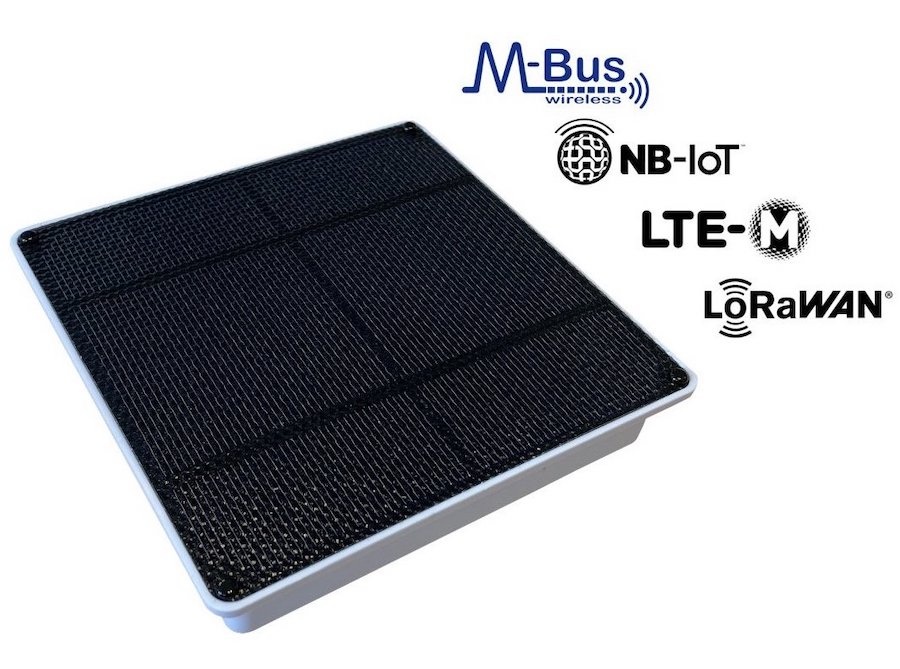This page describes the Lobaro wireless M-Bus gateway firmware, called app-nrf9160-wmbus, which is executable on different hardware variants sold as different products.
Overview
The Lobaro wireless M-Bus gateway firmware collects consumption values from up to 500 commercially available water meters, heat meters, heat cost allocators or similar with 868 MHz wireless M-Bus radio interface or Sensus RF Bubble Up and forwards them encrypted via NB-IoT, LTE-M1 cellular radio or LoRaWAN networks for further processing on the Internet.
Forwarded meter values are transmitted, optionally additionally encrypted via DTLS, to a shared or private instance of the Lobaro IoT platform and can be viewed there or downloaded as a CSV file. Alternatively, standardised APIs such as MQTT, HTTP Push, SFTP or a REST interface are available to connect downstream systems or platforms easily and securely. When using LoRaWAN, the Lobaro Platform is optional. When using NB-IoT or LTE-M, on the other hand, it is mandatory. This requirement is explained in the Lobaro IoT Platform FAQ.
Thanks to the new NB-IoT mobile radio, optimised for sensor data, remote reading even works in places such as basements where smartphones have poor or no reception.
Supported Hardware Platforms / Variants
This firmware, following the naming sheme app-nrf9160-wmbus-TZ2-VERSION-HARDWARE, exists in versions targeted for different Lobaro hardware. On all hardware the workflows and functionality is the same. If a certain firmware feature is not available on a specific hardware variant, this will be indicated separately.
LOB-GW-HYB-WMBUS
"Wireless M-Bus Gateway V3"
- Battery driven variant (3.6V D-Cell)
- Example firmware name: app-nrf9160-wmbus-TZ2-0.14.1+hw3
- Lobaro article number: #8000162 + #3000581 (Battery)
LOB-GW-SUN-WMBUS
"Solar Wireless M-Bus Gateway"
- 100% solar powered variant
- Example firmware name: app-nrf9160-wmbus-TZ2-0.14.1+sun
- Lobaro article number: #8000179
LOB-GW-DINRAIL-HYB-WMBUS
"Wireless M-Bus Gateway (ext. Power, Din-Rail)"
- External 12V-24V powered variant for din-rail mounting
- Example firmware name: app-nrf9160-wmbus-TZ2-0.14.1+dinrail
- Optionally bundled with 230V power-supply and extra shell housing
- Lobaro article number: #8000157 (standalone), #8000158 (bundle)
LOB-GW-WMBUS-NB2 (Discontinued)
"Wireless M-Bus Gateway V2"
- Legacy battery driven variant
- Example firmware name: app-nrf9160-wmbus-TZ2-0.14.1+hw2
- Lobaro article number:
#8000131(discontinued) LoRaWAN not supported
DTLS encryption not supported
Basic Workflow
- The gateway remains in power-saving mode most of the time.
- The unit wakes up at flexible configurable time points, e.g. every hours, every 7th day or every Monday.
- Encrypted wireless M-Bus (868 MHz) telegrams are received for a configurable duration and buffered.
- Reception can be limited to certain devices and types by means of filters.
- After the configured collection duration has been reached, the meter data reception is stopped again.
- The buffered meter telegrams get uploaded afterwards on the Internet
- NB-IoT, LTE-M1: Data is send using UDP, DTLS (optional) and CoAP to the Lobaro IoT platform instance.
- LoRaWAN: Data is send as Class A uplinks to the downstream LoRaWAN server / platform on the internet. Metering telegrams may be spliced and send in multiple uplinks.
- The Lobaro Platform can perform decryption the consumption telegrams with stored keys.
- The consumption values are available in table views inside the Lobaro Platform and as a CSV download
- Data may be forwarded from the Lobaro Platform to additional systems and platforms using one of these APIs: MQTT, REST, HTTPS-PUSH or SFTP.
Network Selection Parameters
WAN
This parameter can be used to set whether cellular IoT (NB-IoT, LTE-M) or LoraWAN is to be used for data transmission. With LoRaWAN, the type of network join can also be defined (ABP vs. OTAA).
| Name | Description | Default Value | Value Description & Examples |
|---|---|---|---|
WAN | Technology used for connection and data uplinks to backend. | lte |
|
Remote Configuration
- Devices using LTE-M or NB-IoT can be configured easily using the interface (search for 'config tab' inside devices) in the Lobaro Platform.
- Devices using LoRaWAN can configured by sending downlinks on port 128:
- A single config parameter can be changed by sending
S<parameter>=<value> - For example: changing the device to switch to using LTE-M or NB-IoT, you would change the parameter "
WAN"to "lte"by sending:"SWAN=lte" - Depending on the used LoRaWAN network servers convention you will to encode this string in Base64 as
"U1dBTj1sdGU="or Hex as"5357414e3d6c7465". - AdditionalI Information: LoRaWAN Downlink Configuration
- A single config parameter can be changed by sending
Compatible wireless meter protocols
- Wireless M-BUS S1, C1 or T1 modes, e.g. unidirectional 868 MHz modes following DIN EN 13757-4.
- Open metering specification (OMS, Annex O): PHY_A - 868 MHz (uplink only)
- Sensus RF Bubble UP - Manufacturer specific radio protocol (Xylem Inc.)
- ME-Funk - Manufacturer specific radio protocol (Müller-electronic GmbH). Decoding of telegrams needs the Lobaro Platform.
433 MHz variants available on special sales request:
- Open metering specification (OMS, Annex O): PHY_B - 433 MHz (uplink only)
- Sensus RF Bubble UP 433 MHz - Manufacturer specific (Xylem Inc.) radio protocol







